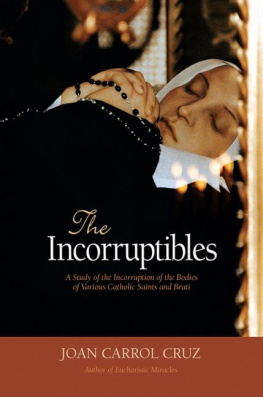Joan Carroll Cruz - Lay Saints: Ascetics and Penitents
Here you can read online Joan Carroll Cruz - Lay Saints: Ascetics and Penitents full text of the book (entire story) in english for free. Download pdf and epub, get meaning, cover and reviews about this ebook. year: 2016, publisher: TAN Books, genre: Non-fiction. Description of the work, (preface) as well as reviews are available. Best literature library LitArk.com created for fans of good reading and offers a wide selection of genres:
Romance novel
Science fiction
Adventure
Detective
Science
History
Home and family
Prose
Art
Politics
Computer
Non-fiction
Religion
Business
Children
Humor
Choose a favorite category and find really read worthwhile books. Enjoy immersion in the world of imagination, feel the emotions of the characters or learn something new for yourself, make an fascinating discovery.

- Book:Lay Saints: Ascetics and Penitents
- Author:
- Publisher:TAN Books
- Genre:
- Year:2016
- Rating:5 / 5
- Favourites:Add to favourites
- Your mark:
- 100
- 1
- 2
- 3
- 4
- 5
Lay Saints: Ascetics and Penitents: summary, description and annotation
We offer to read an annotation, description, summary or preface (depends on what the author of the book "Lay Saints: Ascetics and Penitents" wrote himself). If you haven't found the necessary information about the book — write in the comments, we will try to find it.
Lay Saints: Ascetics and Penitents — read online for free the complete book (whole text) full work
Below is the text of the book, divided by pages. System saving the place of the last page read, allows you to conveniently read the book "Lay Saints: Ascetics and Penitents" online for free, without having to search again every time where you left off. Put a bookmark, and you can go to the page where you finished reading at any time.
Font size:
Interval:
Bookmark:
TAN Books
Charlotte, North Carolina
Copyright 2016 TAN Books.
Lay Saints: Ascetics & Penitents is a selection of saints biographies originally appearing in Secular Saints 1989 by Joan Carroll Cruz. Revisions to the original biographies include updating of diction, punctuation, and spelling, along with the correction of occasional errors in typography, spelling, grammar, syntax, and factual information.
All rights reserved. With the exception of short excerpts used in articles and critical review, no part of this work may be reproduced, transmitted, or stored in any form whatsoever, without the prior written permission of the publisher.
Cover design by David Ferris.
www.davidferrisdesign.com
Cover image: Charity of St. Elizabeth of Hungary, Leighton / Restored Traditions
Cataloging-in-Publication data on file with the Library of Congress.
ISBN: 978-0-89555-708-7
Printed in the United States of America.
TAN Books
Charlotte, North Carolina
www.TANBooks.com
2016
This book is
dedicated with love
to
The Holy Family
A NATIONAL Catholic magazine polled a thousand of its readers to learn what they believe about the saints. The magazine reported that while news reports on the nations Catholics have highlighted disagreements with traditional Church teachings, sixty-seven percent of the surveys respondents said they prayed to the saints as much, or more, than they did years ago. Sixty-eight percent of the respondents said they tried to imitate the lives of the saints.
Mentioned as the four favorite saints were the Blessed Mother, St. Joseph, St. Francis of Assisi, and St. Thrse of Lisieux (the Little Flower). With the exception of the Blessed Mother and St. Joseph, who are in a unique category, we are left with a Franciscan brother and a Discalced Carmelite cloistered nun. While we can admire the virtues of St. Francis and St. Thrse, the lifestyles of these two saints, and other saints of religious orders, are far removed, to say the least, from those of lay people.
Although the exact number of canonized saints is unknown, we know, of course, that the greater majority have been members of religious orders. We love them, we admire them, we wish to imitate them. But how can a mother with small children, a wife with a difficult husband, a young bride with in-law problemshow can they really relate to the nun who lived in the quiet of a cloister, the nun who lived in a community where everyone shared the work of the house? How can they relate to the saints of religious orders whose lives were arranged in an orderly manner and who had designated times for quiet prayer and who had little or no financial problems? One might wonder if these saints of the cloister would have merited their titles if they had remained in the world to face the conflicts and dangers confronted by ordinary lay people.
It is profitable, of course, for laymen to love these saints, to pray to them and to imitate their virtues as much as they are able. But it seems that laymen would draw more encouragement to advance in prayer and virtue and would derive more consolation in their trials by examining the troubles and temptations of those saints who lived and died as lay members of the Church.
St. Teresa of Avila suggests that we need to cultivate and think upon, and seek the companionship of those saints who, though living on earth like ourselves, have accomplished such great deeds for God. Here, then, are the lives of lay saints who have, so to speak, lived on earth like ourselves. Represented here are single men and women, mothers and fathers, soldiers and servants, doctors and lawyers, the humble and the nobleall who have met the difficulties and challenges of the secular life and triumphed over them. Their virtues are to be admired, but most of all imitated. May we benefit from their example and from their prayers.
Joan Carroll Cruz
BLESSED VIRGIN MARY
A BOOK about lay saints would be incomplete without mentioning the pre-eminent model for secular people, the Blessed Mother. But what could be said here that has not been mentioned about her already in numerous biographies and devotional works? We have only to delve into these to find a solicitous and understanding mother, a kindly and generous friend, a consoling companion, and a ready and willing intercessor with God.
Although it is known that Mary was free from sin, full of grace, blessed among women and the fairest honor of our race, yet, as we know, she was not exempt from countless trials and hardships. She, who was the model of saints throughout the ages, should be the particular ideal of lay people, since Mary was an exemplary member of our lay ranks. She was, of course, a young bride, a young mother, a housekeeper, and a widow.
May this Immaculate Mother pray for us, that in our imitation of the saints, we can advance in virtue and eventually join her and her sainted children in our heavenly homeland.
Then shall the king say to them that shall be on his right hand: Come, ye blessed of my Father, possess you the kingdom prepared for you from the foundation of the world. For I was hungry, and you gave me to eat; I was thirsty, and you gave me to drink; I was a stranger, and you took me in: Naked, and you covered me: sick, and you visited me: I was in prison, and you came to me.
Matthew 25:3436
But if the wicked do penance for all his sins which he hath committed, and keep all my commandments, and do judgment, and justice, living he shall live, and shall not die. I will not remember all his iniquities that he hath done: in his justice which he hath wrought, he shall live.
Ezekiel 18:2122
ASCETICS, AND
SOLITARIES
T HE little town of Lugo, situated fourteen miles west of Ravenna, Italy was the place of Bl. Bonavitas birth and death. Here he worked as a humble blacksmith, spending his time either at labor or in the performance of good works. It is recorded of him that whether working or at leisure, whether sitting or walking, indoors or out of doors, he was often so rapt in contemplation as to be unaware of all that was taking place around him. This was demonstrated the day a fire destroyed many of the houses in Lugo. When the whole population of the city was feverishly working to extinguish the fire, Bl. Bonavita passed by, totally unaware of what was taking place. When his attention was gained, he made the Sign of the Cross over the flames. From that moment the fire is said to have been totally extinguished.
As a Franciscan tertiary, Bonavita had the true spirit of the Order and a love of poverty. His zeal for the poor was shown one bitter, wintry day when he found a poor man half frozen outside the church of San Francesco. Bonavita immediately gave the man his own clothes. The little urchins of the town ran after the nearly naked blacksmith, throwing stones at him and shouting words of abuse. On another occasion, Bonavita gave his newly mended shoes to a beggar. With the proceeds from his strenuous profession, it was his custom to feed the hungry, to visit prisons, and to bury the dead.
Through his prayers, and with the Sign of the Cross, Bl. Bonavita worked many wonders. He died a holy death in the year 1375.
PICCOLOMINI
Font size:
Interval:
Bookmark:
Similar books «Lay Saints: Ascetics and Penitents»
Look at similar books to Lay Saints: Ascetics and Penitents. We have selected literature similar in name and meaning in the hope of providing readers with more options to find new, interesting, not yet read works.
Discussion, reviews of the book Lay Saints: Ascetics and Penitents and just readers' own opinions. Leave your comments, write what you think about the work, its meaning or the main characters. Specify what exactly you liked and what you didn't like, and why you think so.




